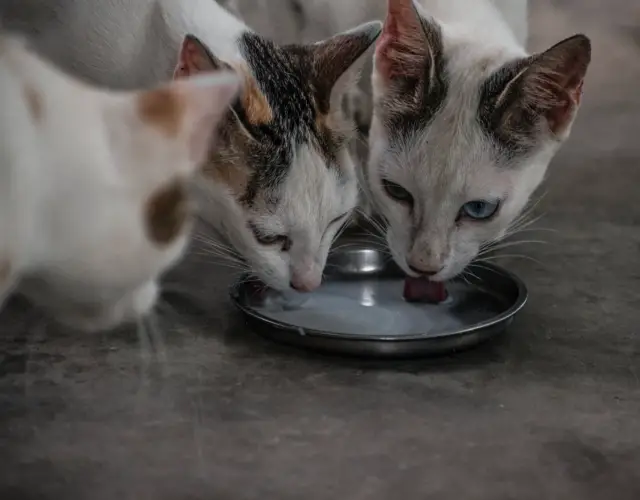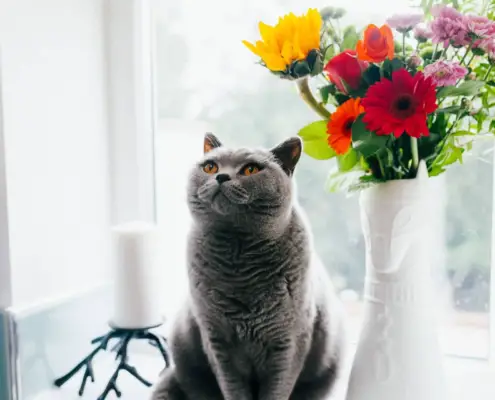
Lactose intolerance is a common condition in humans, but can cats be lactose intolerant too? It’s an important question for cat owners to consider, as many of us have grown up with the image of a contented cat lapping up a saucer of milk. However, the truth is that cats can indeed be lactose intolerant.
Lactose is a sugar found in milk and other dairy products. It needs to be broken down into simpler forms by an enzyme called lactase in order to be properly digested. Cats, like many other mammals, have the ability to produce lactase when they are young and still nursing from their mothers. However, as they grow older, the production of lactase decreases. This reduction in lactase levels can lead to lactose intolerance in cats.
Signs and symptoms of lactose intolerance in cats
If your cat is lactose intolerant, you may notice a range of signs and symptoms. These can vary from mild to severe and may include:
- Digestive issues: Cats who are lactose intolerant may experience diarrhea, vomiting, or stomach discomfort after consuming milk or dairy products.
- Flatulence: Excessive gas is another common symptom of lactose intolerance in cats. If you notice your cat passing gas more frequently than usual, it could be a sign of lactose intolerance.
- Decreased appetite: Cats with lactose intolerance may also show a reduced interest in food. This can be due to the discomfort caused by the digestive issues associated with lactose intolerance.
If you observe any of these symptoms in your cat after they consume milk or dairy products, it’s important to consult with your veterinarian to determine if lactose intolerance is the cause.
Can cats drink milk?
Contrary to popular belief, cats don’t actually need to drink milk. In fact, once they are weaned from their mother’s milk, cats no longer require lactose in their diet. Adult cats are generally lactose intolerant, meaning they lack the necessary enzyme to properly digest lactose.
Feeding your cat milk can lead to digestive upset and discomfort. It’s important to note that lactose intolerance is different from a milk allergy. While lactose intolerance is the inability to digest lactose, a milk allergy is an immune response to the proteins found in milk. Both conditions can cause similar symptoms, but they have different underlying causes.
It’s best to avoid giving your cat milk altogether. Instead, provide them with a well-balanced diet that meets their nutritional needs without the need for dairy products.
The science behind lactose intolerance in cats
The science behind lactose intolerance in cats lies in their genetics and physiology. Like other mammals, cats produce the enzyme lactase when they are young and still nursing. Lactase allows them to break down lactose into simpler forms that can be easily absorbed by their bodies.
As cats grow older and are weaned from their mother’s milk, the production of lactase naturally decreases. This is because cats’ bodies are no longer dependent on milk for their nutritional needs. The reduced production of lactase leads to lactose intolerance in adult cats.
It’s important to note that lactose intolerance is not a disease or a condition that can be cured. It is simply a natural part of a cat’s development. While some cats may be more sensitive to lactose than others, it is generally best to avoid giving them milk or dairy products to prevent digestive issues.
How to test if your cat is lactose intolerant
If you suspect that your cat may be lactose intolerant, there are a few ways to test for this condition. One option is to remove all dairy products from your cat’s diet for a period of time and observe if their symptoms improve. This can help determine if lactose intolerance is the underlying cause of their digestive issues.
Another option is to consult with your veterinarian. They may recommend a lactose intolerance test, which involves giving your cat a small amount of lactose and monitoring their reaction. This can help confirm the diagnosis and guide you in managing your cat’s diet.
It’s important to remember that lactose intolerance in cats is a common condition and can be managed with proper diet and nutrition.
Managing lactose intolerance in cats
If your cat is diagnosed with lactose intolerance, there are several ways to manage their condition and ensure they receive proper nutrition:
- Avoid dairy products: The most important step is to completely eliminate dairy products from your cat’s diet. This includes milk, cheese, yogurt, and any other dairy-based treats or foods.
- Read labels: When purchasing cat food or treats, carefully read the labels to ensure they are lactose-free. Look for products that are specifically formulated for cats with lactose intolerance.
- Consider lactose-free alternatives: There are lactose-free alternatives available for cats, such as lactose-free milk or cat-friendly milk substitutes. These products are specifically designed to be easily digestible for cats with lactose intolerance.
By following these steps, you can help manage your cat’s lactose intolerance and ensure they receive the proper nutrition they need without causing digestive upset.
Lactose-free alternatives for cats
While cats may not be able to tolerate lactose, there are several lactose-free alternatives available that can still provide them with a tasty treat. Here are a few options to consider:
- Lactose-free milk: Lactose-free milk is a great alternative to regular milk for cats. It is specifically formulated to be easily digestible and does not contain lactose. However, it’s important to note that milk should only be given as an occasional treat and not as a regular part of your cat’s diet.
- Cat-friendly milk substitutes: There are also milk substitutes available that are specifically formulated for cats. These products are typically made from plant-based ingredients and are designed to be easily digestible for cats with lactose intolerance.
- Homemade lactose-free treats: Another option is to make your own lactose-free treats at home. There are several recipes available online that use lactose-free ingredients and are safe for cats with lactose intolerance. This allows you to control the ingredients and ensure your cat’s treats are free from lactose.
When introducing any new food or treat to your cat, it’s important to do so gradually and monitor their reaction. Every cat is unique, so what works for one may not work for another. If you have any concerns or questions, consult with your veterinarian for guidance.
Homemade lactose-free cat treats and recipes
If you enjoy getting creative in the kitchen, making homemade lactose-free treats for your cat can be a fun and rewarding experience. Here are a few simple recipes to get you started:
- Tuna and pumpkin bites: Combine canned tuna (in water, not oil) with a small amount of canned pumpkin. Form the mixture into small bite-sized balls and place them on a baking sheet. Bake in the oven at a low temperature until they are firm. Let them cool completely before serving.
- Chicken and sweet potato cookies: Cook boneless chicken breast and sweet potato until they are tender. Mash them together and form the mixture into small cookie shapes. Place them on a baking sheet and bake in the oven until they are cooked through. Allow them to cool before giving them to your cat.
- Salmon and quinoa balls: Cook quinoa according to the package instructions and let it cool. Combine cooked quinoa with canned salmon and form the mixture into small balls. Place them on a baking sheet and bake in the oven until they are crispy. Let them cool before serving.
Remember to always use ingredients that are safe for cats and avoid adding any seasonings or spices. It’s also important to introduce new treats gradually and monitor your cat’s reaction.
Tips for preventing lactose intolerance in cats
While lactose intolerance is a natural part of a cat’s development, there are some steps you can take to help prevent it or minimize its impact:
- Proper weaning: When weaning your kitten, gradually introduce solid food and reduce their dependency on their mother’s milk. This can help their bodies adjust to the reduced production of lactase.
- Choose a lactose-free diet: If you are adopting a kitten or introducing a new cat into your home, consider choosing a lactose-free diet from the start. This can help prevent the development of lactose intolerance in the first place.
- Regular veterinary check-ups: Regular veterinary check-ups are essential for monitoring your cat’s health and detecting any potential issues early on. Your veterinarian can provide guidance on proper nutrition and help you make informed decisions about your cat’s diet.
By following these tips, you can help promote your cat’s overall digestive health and reduce the risk of lactose intolerance.
Conclusion
In conclusion, cats can indeed be lactose intolerant. As they grow older, their bodies naturally produce less lactase, the enzyme needed to digest lactose. This can lead to digestive issues and discomfort when cats consume milk or dairy products.
If you suspect that your cat may be lactose intolerant, it’s important to consult with your veterinarian for proper diagnosis and guidance. By managing their condition through a lactose-free diet and providing them with suitable alternatives and treats, you can ensure your cat’s digestive health and overall well-being.
Remember, just because cats are often depicted as milk lovers in popular culture, it doesn’t mean it’s a healthy or necessary part of their diet. Providing them with a well-balanced, lactose-free diet is the best way to keep them happy and healthy.
If you suspect that your cat may be lactose intolerant, consult with your veterinarian for guidance on managing their condition and providing them with suitable alternatives. Remember, a well-balanced, lactose-free diet is key to keeping your cat healthy and happy.
If you enjoyed my article, I would appreciate you sharing it with your network.

Sima Ndlebe
Sima writes for CatBuzz. He is interested in Cats, Health and Fitness, and Entrepreneurship.
Published: 17 November 2023
Related Articles
Disclaimer
The content found on CatBuzz.org is presented on an "as is" basis and is intended for general consumer information and education purposes only. Any utilization of this information is voluntary and solely at the user's own risk.
None of the articles or content should be regarded as, or used in place of, veterinary medical advice, diagnosis, or treatment. The information provided on the website is purely for educational and informational intentions and should not be considered a substitute for professional guidance from a veterinarian or other qualified expert. The articles are designed to inform consumers about veterinary healthcare and medical matters that may impact their cat's daily life. It should be noted that this website and its services do not constitute the practice of any form of veterinary medical advice, diagnosis, or treatment. CatBuzz.org explicitly disclaims any liability for any direct or indirect damages or losses that may arise from the use of or reliance on the information contained within the content.
Consumers must consult a veterinarian, veterinary specialist, or another qualified veterinary healthcare provider when seeking advice regarding their cat's health or medical conditions. It is important not to ignore, avoid, or postpone seeking medical advice from a veterinarian or other qualified veterinary healthcare provider solely based on information obtained from this website. If you believe that your cat may be experiencing a medical issue or condition, it is imperative to promptly contact a qualified veterinary healthcare professional.




